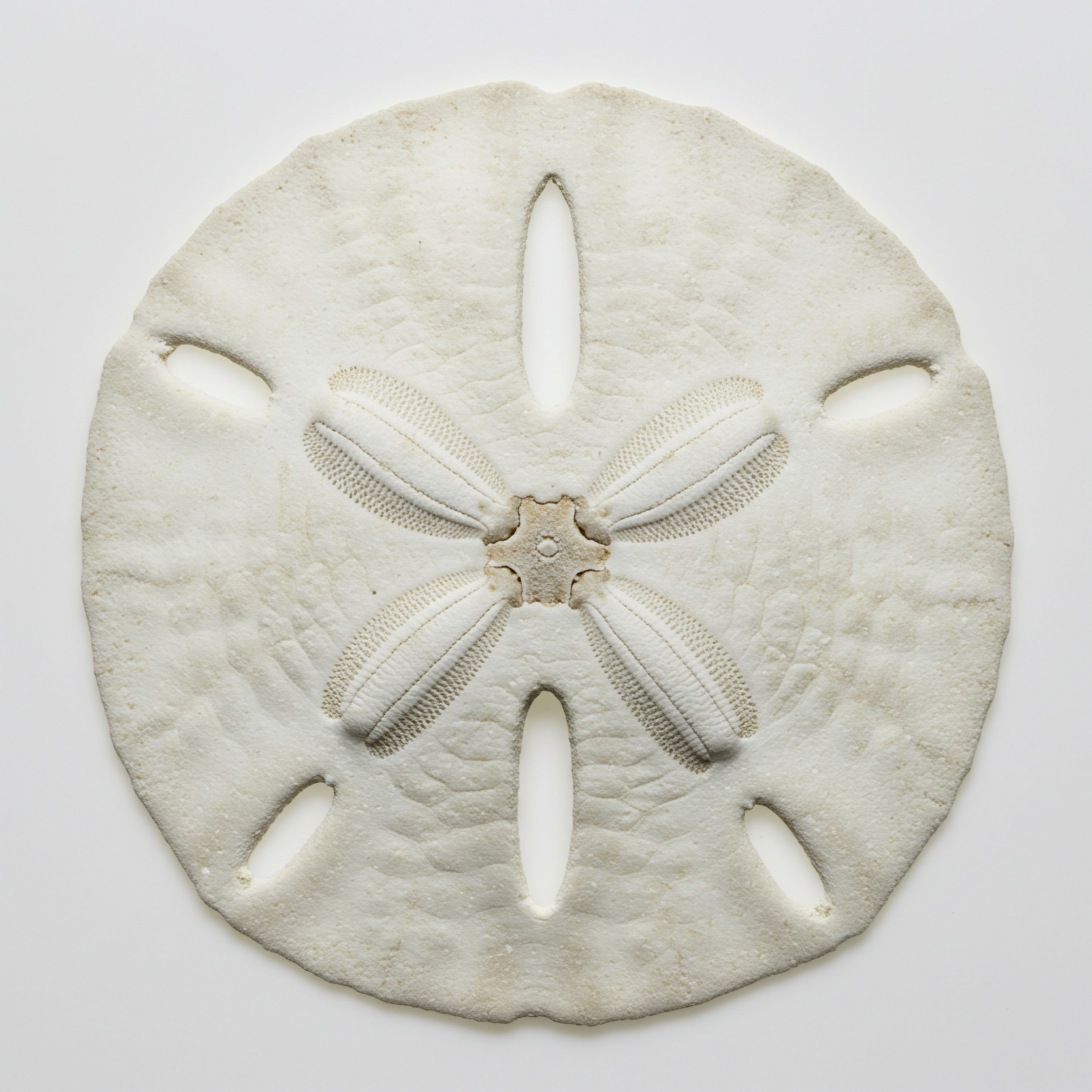

Fundamentals
That feeling of persistent bloating, the subtle puffiness in your hands and feet, is a tangible experience rooted in the intricate communication network of your endocrine system. Many individuals notice these shifts and simultaneously harbor a quiet concern about their long-term heart health, sensing a connection that science is now clearly illuminating.
Your body’s internal symphony is conducted by hormones, chemical messengers that regulate everything from your mood to your metabolism. When this symphony is in tune, systems operate seamlessly. When a few key instruments are out of sync, the resulting dissonance manifests as physical symptoms, including the fluid retention that troubles you and the cardiovascular changes that concern you.
At the heart of this issue are specific hormonal players and their profound influence on how your body manages salt and water. Think of your circulatory system as a complex hydraulic network. Hormones are the master controllers of this network, dictating fluid volume and pressure with remarkable precision. Understanding their roles is the first step toward reclaiming control over your biological systems.

The Key Hormonal Regulators
The balance of fluid within your body is a dynamic process, meticulously managed by a select group of hormones. Each has a distinct role, yet they function in a state of constant interaction, where the level of one directly influences the action of others. A disturbance in this delicate equilibrium can lead to the retention of excess fluid and place undue stress on your cardiovascular system.

Meet the Conductors of Fluid Balance
- Estrogen This hormone, while essential for numerous bodily functions, can signal the kidneys to retain sodium. Where sodium goes, water follows, leading to an increase in overall fluid volume.
- Progesterone In a beautifully designed counterbalance, progesterone can act as a natural diuretic. It competes with aldosterone, a powerful salt-retaining hormone, at the kidney’s receptor sites, promoting the excretion of sodium and water.
- Testosterone While its direct effects on fluid are less pronounced, testosterone’s metabolic pathway is significant. A portion of testosterone is naturally converted into estrogen via an enzyme called aromatase. This conversion can disrupt the testosterone-to-estrogen ratio, contributing to fluid retention.
- Aldosterone As a primary component of the renin-angiotensin-aldosterone system (RAAS), this steroid hormone is a master regulator of blood pressure. It directly instructs the kidneys to conserve sodium, thereby increasing fluid retention and blood volume.
Hormonal fluctuations directly command the kidneys’ management of salt and water, linking endocrine health to fluid balance and cardiovascular pressure.
The lived experience of bloating or a rising blood pressure reading is your body communicating a deeper systemic imbalance. These are not isolated events but signals of an underlying endocrine disruption. By viewing these symptoms through the lens of hormonal interplay, you can begin to see a clear path toward resolution. The goal is to restore the system’s inherent harmony, allowing your body to function with the vitality and efficiency it was designed for.


Intermediate
Moving from the fundamental “what” to the clinical “how” reveals the therapeutic power of personalized hormone protocols. These are not one-size-fits-all solutions but are instead meticulously calibrated interventions designed to restore your body’s specific biochemical equilibrium. The objective is to adjust the hormonal symphony conductor by conductor, ensuring each section is playing its part correctly. This recalibration directly addresses the mechanisms behind fluid retention and provides a strong defense for your cardiovascular system.
A properly designed protocol recognizes that hormones do not act in isolation. For instance, administering testosterone without accounting for its potential conversion to estrogen can exacerbate the very symptoms you seek to alleviate. Therefore, a sophisticated approach involves a multi-faceted strategy, often incorporating agents that manage these metabolic pathways alongside the primary hormone therapy.

How Do Personalized Protocols Restore Balance?
A personalized protocol begins with comprehensive lab work to identify the specific nature of the hormonal imbalance. Based on this data, a clinician can construct a therapeutic plan that targets the root cause of the fluid and cardiovascular symptoms. This involves selecting the right hormones, in the right dosages, delivered via the right method, and often complemented by ancillary medications that fine-tune the body’s response.

Clinical Strategies for Hormonal Optimization
For men experiencing symptoms of low testosterone, a standard and effective protocol involves weekly intramuscular injections of Testosterone Cypionate. This steady administration helps to normalize testosterone levels, improving energy, libido, and muscle mass. This primary therapy is often paired with two critical supporting agents.
- Anastrozole This oral tablet is an aromatase inhibitor. It works by blocking the enzyme that converts testosterone into estrogen. By carefully managing this conversion, Anastrozole prevents the buildup of excess estrogen, directly mitigating the risk of fluid retention and gynecomastia.
- Gonadorelin Administered as a subcutaneous injection, Gonadorelin helps maintain the body’s natural testosterone production pathway by stimulating the pituitary gland. This supports testicular function and fertility, creating a more holistic and sustainable hormonal environment.
For women, particularly in the perimenopausal and postmenopausal stages, protocols are designed to address the decline in both progesterone and testosterone, while carefully considering the role of estrogen.
| Hormone/Agent | Primary Action | Effect on Fluid Retention | Cardiovascular Implication |
|---|---|---|---|
| Testosterone | Restores androgen levels | Neutral (when aromatization is controlled) | Improves endothelial function and lipid profiles. |
| Progesterone | Balances estrogen | Decreases (natural diuretic effect) | May help regulate blood pressure. |
| Estrogen | Regulates female cycle | Increases (promotes sodium retention) | Complex effects; can be prothrombotic if unopposed. |
| Anastrozole | Inhibits aromatase enzyme | Decreases (by lowering estrogen levels) | Supports a favorable testosterone-to-estrogen ratio. |
Effective hormone therapy relies on managing metabolic pathways, such as the conversion of testosterone to estrogen, to prevent side effects like fluid retention.
Protocols for women often utilize low-dose Testosterone Cypionate injections to restore energy and libido, combined with bio-identical Progesterone. Progesterone is particularly valuable as it naturally competes with aldosterone, promoting the excretion of excess sodium and water and thus directly counteracting bloating. The precise combination and dosage are tailored to the individual’s unique physiology and symptoms, ensuring a therapeutic effect that feels both restorative and protective.


Academic
A sophisticated analysis of hormonal influence on fluid dynamics and cardiovascular health necessitates a deep examination of the Renin-Angiotensin-Aldosterone System (RAAS). This complex, multi-organ endocrine cascade is the body’s principal mechanism for regulating blood pressure, plasma sodium concentration, and arterial vasoconstriction.
Sex hormones do not merely influence this system; they are potent modulators of its core components, acting at the level of gene expression and receptor sensitivity. Understanding this interplay is paramount to appreciating how personalized hormonal therapies can confer their protective effects.
Estrogen, for example, directly stimulates the hepatic synthesis of angiotensinogen, the precursor molecule for the entire RAAS cascade. An elevation in angiotensinogen provides more substrate for renin to act upon, potentially leading to increased production of angiotensin II and subsequent aldosterone secretion. This mechanism underpins the fluid retention often observed in states of estrogen dominance. A personalized protocol seeks to restore a physiological hormonal balance, thereby normalizing the baseline activity of the RAAS.

What Is the Molecular Dialogue between Hormones and the RAAS?
The interaction between sex hormones and the RAAS is a nuanced dialogue occurring at the cellular level. Progesterone and certain progestins, for instance, exhibit an antagonistic relationship with the mineralocorticoid receptor, the cellular target for aldosterone.
By competing with aldosterone for this receptor in the distal nephrons of the kidney, progesterone can induce natriuresis ∞ the excretion of sodium in the urine ∞ effectively countering the salt-retaining effects of both aldosterone and estrogen. This competitive inhibition is a key mechanism through which progesterone helps to maintain fluid homeostasis.
Sex hormones directly modulate the Renin-Angiotensin-Aldosterone System, altering the foundational processes that govern blood pressure and fluid volume.
Furthermore, testosterone’s role extends beyond its potential aromatization. Androgen receptors are present on vascular endothelial cells, and testosterone has been shown to promote vasodilation, partly through the enhancement of nitric oxide bioavailability. This action can improve endothelial function, a critical factor in maintaining cardiovascular health.
However, when supraphysiological levels of estrogen are generated via uncontrolled aromatization during testosterone therapy, these benefits can be negated by estrogen’s opposing effects on the vasculature and the RAAS. The co-administration of an aromatase inhibitor like Anastrozole is a clinical strategy grounded in this molecular reality. It ensures that the therapeutic benefits of testosterone are realized without activating the fluid-retaining and potentially pro-hypertensive pathways associated with excess estrogen.

Systemic Implications for Cardiovascular Integrity
The long-term integrity of the cardiovascular system is dependent on maintaining optimal endothelial function, managing arterial stiffness, and preventing cardiac remodeling. Research indicates that low endogenous testosterone is associated with an increased risk of adverse cardiovascular events. Thoughtfully administered testosterone replacement therapy has been demonstrated to improve several cardiometabolic markers, including insulin sensitivity and lipid profiles, and may reduce inflammatory markers.
The table below outlines the specific interactions between key hormones and components of the cardiovascular and renal systems, illustrating the mechanistic basis for personalized therapeutic interventions.
| Hormone | Target System | Molecular Action | Physiological Outcome |
|---|---|---|---|
| Estrogen | RAAS / Liver | Upregulates angiotensinogen synthesis. | Increases potential for RAAS activation and fluid retention. |
| Progesterone | Kidney (Distal Nephron) | Competes with aldosterone for the mineralocorticoid receptor. | Promotes natriuresis and reduces fluid volume. |
| Testosterone | Vascular Endothelium | Enhances nitric oxide synthase activity. | Promotes vasodilation and improves blood flow. |
| Aldosterone | Kidney / Vasculature | Binds to mineralocorticoid receptors. | Increases sodium reabsorption and vasoconstriction. |
The ultimate goal of a personalized hormone protocol is to re-establish a systemic endocrine environment that supports, rather than stresses, the cardiovascular system. This is achieved by looking beyond a single hormone level and instead managing the intricate web of interactions that collectively determine vascular tone, fluid balance, and metabolic health.

References
- Stachenfeld, N. S. “Sex hormone effects on body fluid regulation.” Exercise and sport sciences reviews vol. 36,3 (2008) ∞ 152-9.
- Oelkers, W K. “Effects of estrogens and progestogens on the renin-aldosterone system and blood pressure.” Steroids vol. 61,4 (1996) ∞ 166-71.
- de Ronde, W. and F. H. de Jong. “Aromatase inhibitors in men ∞ effects and therapeutic options.” Reproductive biology and endocrinology ∞ RB&E vol. 9 93. 5 Jun. 2011.
- Traish, A. M. et al. “Testosterone and the cardiovascular system ∞ a comprehensive review of the clinical literature.” Journal of the American Heart Association vol. 2,6 (2013) ∞ e000272.
- Corona, G. et al. “Testosterone replacement therapy and cardiovascular risk ∞ a review.” Journal of endocrinological investigation vol. 39,6 (2016) ∞ 609-24.

Reflection
You have now explored the biological architecture connecting your endocrine system to your daily experience of well-being and your long-term cardiovascular future. This knowledge transforms abstract symptoms into clear, understandable signals from your body. The sensation of bloating is no longer a vague discomfort but a specific message about sodium balance and hormonal interplay.
This understanding is the foundational tool for building a more resilient and vital self. Your personal health narrative is an ongoing dialogue with your own physiology, and you are now better equipped to participate in that conversation with intention and insight.

Glossary

fluid retention

cardiovascular system

aldosterone

renin-angiotensin-aldosterone system

blood pressure

hormone therapy

testosterone cypionate

testosterone levels

aromatase inhibitor

anastrozole

bio-identical progesterone

low-dose testosterone

cardiovascular health

vasoconstriction

angiotensinogen

mineralocorticoid receptor

fluid homeostasis

natriuresis




